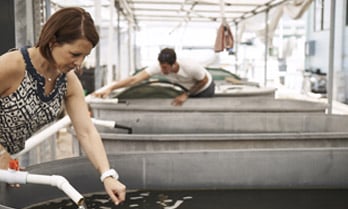Dr Kathryn Holt, Bio21 Institute, The University of Melbourne
01 September 2013
Tracking the spread of deadly diseases
Kat Holt is using genetics, maths and supercomputers to study the whole genome of deadly bacteria and work out how they spread. Studying a typhoid epidemic in Kathmandu, she found that it didn’t spread in the way we thought epidemics did. Her research, published in Nature Genetics, will change how we go about responding to epidemics.
Her L’Oréal For Women in Science Fellowship allowed Kat to use the same techniques to understand how antibiotic-resistant bacteria spread in Melbourne hospitals. Are people catching these superbugs in hospital, or are they bringing the bugs into hospital with them? Can we give the intensive care clinicians early warning of a drug-resistant bacteria in their patients?
Qualifications
| 2011 | Masters in Epidemiology, The University of Melbourne |
| 2009 | PhD (Molecular biology), Wellcome Trust Sanger Institute and The University of Cambridge, UK |
| 2004 | Bachelor of Science with Honours (Genetics)/Bachelor of Arts, The University of Western Australia |
Career highlights, awards, fellowships, grants
| 2013-2015 | Chief investigator on National Health and Medical Research Council (NHMRC) project grant Identifying key players in the spread of antimicrobial resistance, worth over $785,000 |
| 2013-2016 | Chief investigator on four other NHMRC research grants, worth over $2.2 million |
| 2013 | Invited seminar speaker, Molecular Microbiology Meeting, Sydney |
| 2012-present | Research Fellow/NHMRC Early Career Fellow, Bio21 Institute, Dept Biochemistry and Molecular Biology, The University of Melbourne |
| 2012-present | Honorary Research Fellow, Telethon Institute for Child Health Research, WA |
| 2012 | CASS Foundation Travel Grant to attend Molecular Epidemiology and Evolutionary Genetics of Infectious Diseases conference, US |
| 2012 | Visiting Researcher, Pasteur Institute, France, funded by Rod Rickards Fellowship and administered by Australian Academy of Science |
| 2012 | Invited conference speaker, UK Society for General Microbiology Conference, Dublin, Ireland |
| 2012 | Invited seminar speaker, Giessen University, Germany |
| 2012 | Invited conference speaker, session chair and workshop convenor, Australian Society for Microbiology Annual Conference, Brisbane. |
| 2011-2012 | Victorian Department of Health Food Safety Evidence for Policy Research Grant, Genetic fingerprinting of Listeria and Salmonella: How Different is Different? |
| 2011 | Early Career Researcher Grant, The University of Melbourne |
| 2010 | Invited seminar speaker, Pasteur Institute, Paris |
| 2010-2012 | Postdoctoral Research Fellow, Department of Microbiology & Immunology, The University of Melbourne |
| 2005-2009 | PhD Studentship, Wellcome Trust Sanger Institute, Molecular Pathogenesis, UK |
| 2005 | Research Technician, Bioinformatics Division, Walter and Eliza Hall Institute |
| 2004-2005 | Graduate Research Assistant, Department of Biochemistry, University of Western Australia |
| 2002-2005 | Research Assistant, Telethon Institute for Child Health Research, WA |
| 2002-2003 | Contract Programmer, CreativityCorp |
Top five publications
Holt KE, Parkhill J, Mazzoni CJ, Roumagnac P, Weill FX, Goodhead I, Rance R, Baker S, Maskell D, Wain J, Dolecek C, Achtman M and Dougan G (2008) High-throughput sequencing provides insights into genome variation and evolution in Salmonella Typhi, Nature Genetics 40(8):987-993. (Impact factor 36, 236 citations)
Holt KE, Baker S, Weill FX, Holmes EC, Kitchen A, Yu J, Sangal V, Brown DJ, Coia JE, Kim DW, Choi SY, Kim SH, da Silveira WD, Pickard DJ, Farrar JJ, Parkhill J, Dougan G and Thomson NR (2012) Shigella sonnei genome sequencing and phylogenetic analysis indicate recent global dissemination from Europe, Nature Genetics44(9):1056-1059. (Impact factor 36, 17 citations)
Holt KE, Thomson NR, Wain J, Langridge G, Hasan R, Bhutta ZA, Quail MA, Norbertczak H, Walker D, Simmonds M, White B, Bason N, Mungall K, Dougan G and Parkhill J (2009) Pseudogene accumulation in the evolutionary histories of Salmonella enterica serovars Paratyphi A and Typhi, BMC Genomics 10:36. (Impact factor 4, 53 citations)
Heaton T, Rowe J, Turner S, Aalberse RC, de Klerk N, Suriyaarachchi D, Serralha M, Holt BJ, Hollams E, Yerkovich S, Holt K, Sly PD, Goldblatt J, Le Souef P and Holt PG (2005) An immunoepidemiological approach to asthma: identification of in vitro T-cell response patterns associated with different wheezing phenotypes amongst 11 year olds, Lancet 365(9454):142-149. (Impact factor 34, 220 citations)
Rohde H, Qin J, Cui Y, Li D, Loman NJ, Hentschke M, Chen W, Pu F, Peng Y, Li J, Xi F, Li S, Li Y, Zhang Z, Yang X, Zhao M, Wang P, Guan Y, Cen Z, Zhao X, Christner M, Kobbe R, Loos S, Oh J, Yang L, Danchin A, Gao GF, Song Y, Li Y, Yang H, Wang J, Xu J, Pallen MJ, Wang J, Aepfelbacher M, Yang R, E. coli O104:H4 Genome Analysis Crowd-Sourcing Consortium (Holt KE, Studholme DJ, Feldgarden M, Manrique M) (2011) Open-source genomic analysis of Shiga-toxin-producing E. coli O104:H4, The New England Journal of Medicine 365(8):718-724. (Impact factor 53, 161 citations)




